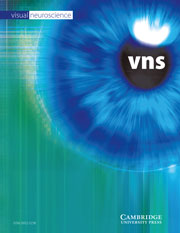Article contents
N-cholinergic facilitation of glutamate release from an individual retinotectal fiber in frog
Published online by Cambridge University Press: 11 January 2002
Abstract
Nicotinic acetylcholine receptors are localized on retinotectal axons' terminals in lower vertebrates. The effects of activation of these receptors by endogenous acetylcholine were observed under stimulation of mass optic fibers. This study was designed to determine whether endogenous acetylcholine facilitates frog retinotectal transmission, provided only the synapses of an individual optic axon are activated, and to evaluate the feasible extent of nicotinic facilitation in these synapses by applied agonist. To this end, the effects of cholinergic drugs on the extracellular action and synaptic potentials recorded from the terminal arborization of a separate retinotectal fiber (in layer F of the tectum) were investigated in vivo. Glutamatergic nature of retinotectal synapses was reexamined by treatment with kynurenic acid. Both kynurenic acid (0.25–1 mM) and d-tubocurarine chloride (10–15 μM) significantly depressed the synaptic potentials. Carbamylcholine chloride (50–150 μM) evoked a large augmentation of the synaptic potentials and a slight but statistically significant decrease of the action potentials. D-tubocurarine reduced the effect of carbamylcholine. Pilocarpine hydrochloride (50 μM) had only a weak effect. The paired-pulse facilitation of the synaptic potentials changed significantly under the action of carbamylcholine and d-tubocurarine. The obtained results suggest that the glutamate release from activated synapses of individual retinotectal axons is facilitated by endogenous acetylcholine via presynaptic nicotinic receptors. Under used stimulation conditions, this modulation mechanism was employed only partially since its activation by applied carbamylcholine could enhance synaptic transmission up to 2.8 times.
- Type
- Research Article
- Information
- Copyright
- 2001 Cambridge University Press
- 16
- Cited by




